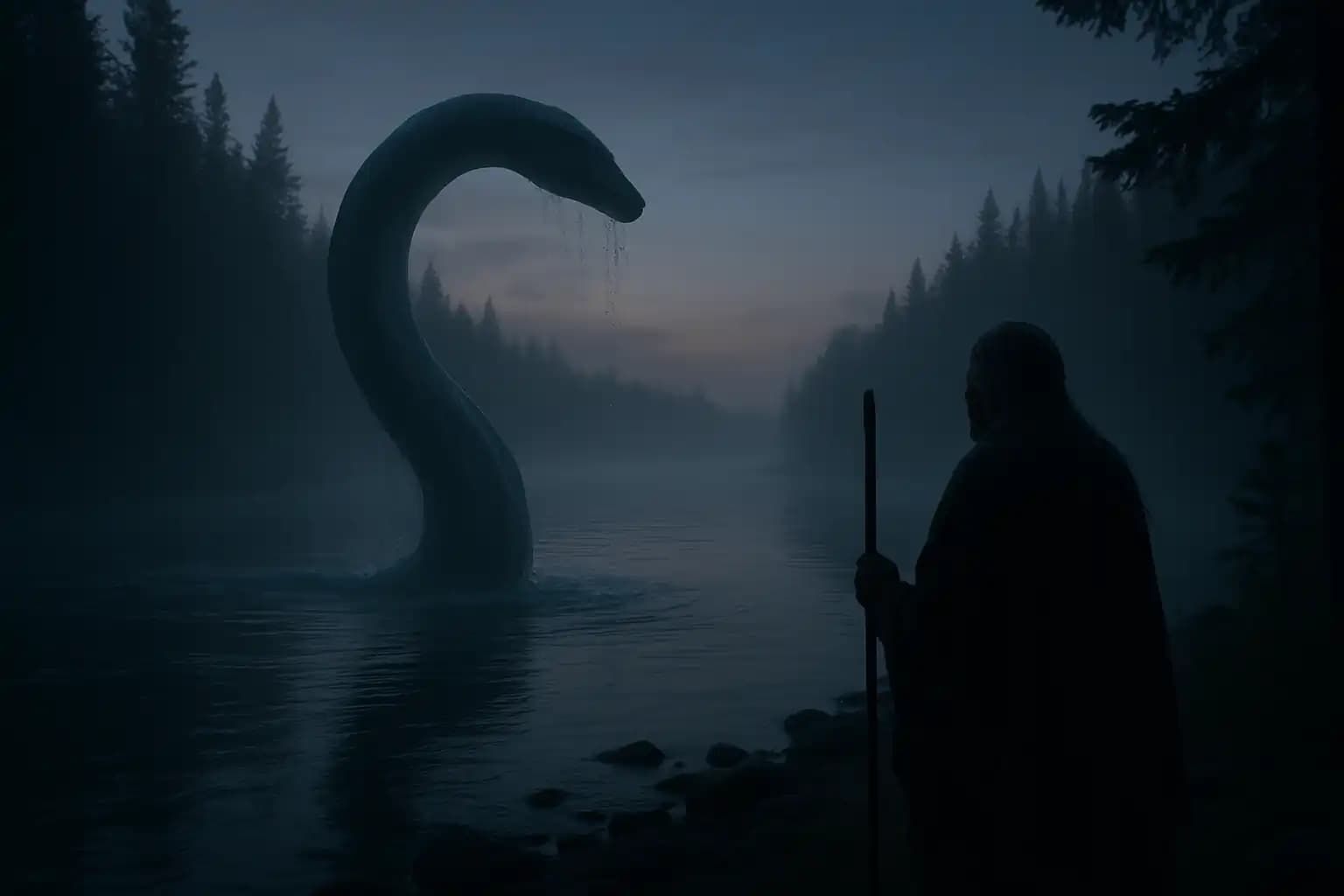On a summer evening outside Old Crow, Yukon, the sun dips but never sets. A chill rides the river flats while mosquitoes orbit. At a cultural center built of weathered spruce, Gwich’in storyteller Celestine Kyikavichik hunches over a drum, tracing coils with an ochre-stained fingertip. “They lived under us,” she says of the Snake People, as her grandparents called them. “They came up in spring, bright as wet stone, and they spoke a language you felt in your heart first, then in your ears.” The cracked drum skin throbs under her palm. “When the last ice age melted, they followed the rivers east. Some stayed. Some watched.”
Canada’s national mythology tends to spotlight lumberjacks, voyageurs, and hockey gloves. Shift your gaze beyond textbook illustrations, and the narrative unfurls into stranger territory. Across the boreal line and south through prairies where choking dust once buried homesteads, many First Nations remember ancient neighbors who were neither fully human nor wholly reptile. Scholars catalog them under various dialect names—Sųdzuháʼ for the Gwich’in, Suyetupi among the Blackfoot, and Nakoda oral histories of the Stoney Nation. These serpentine figures guard Lake Nipissing’s copper-blue depths. Each tale functions as a regional chapter in a single, mysterious saga of sentient serpents entwined with people in uneasy partnership.
The archive remains fragmented, passed mostly through winter lodge storytelling or casual campfire reminiscences, yet patterns recur. The Snake People emerge from water or earth, sometimes coaxing humans into hunts, other times punishing greed with drought or avalanche. Their shapeshifting hinges on uncanny liminality—they slough off scales for moccasins, yet never fully abandon the hiss under words. That dual nature echoes myths of First Nations trickster heroes who straddle ecosystems, while also foreshadowing modern hybrid imaginaries: the cryptids haunting subreddit feeds, the biomechanical aliens stalking late-night cable.
Anthropologist Dr. Andrew Heintzman, who has spent two decades gathering Northern Dene oral traditions, argues the Snake People story “works like cultural Velcro,” latching onto evolving threats. During fur-trade fever, the serpents hoarded silver musket balls. In the 1960s pipeline boom, they guarded undiscovered gas pockets. Today, as Arctic permafrost buckles, Gwich’in elders claim that the rumble of collapsing ice awakens the cold-blooded watchers. Heintzman believes such elasticity explains the legend’s persistence. “It moves with the people,” he notes, much as the Athabasca River snakes across gravel bars after a flood.
However, oral accounts alone do not satisfy late-capitalist curiosity. Enter forensics. Park wardens in Wood Buffalo discovered gastrolith-smooth stones arranged in perfect spirals beside a remote creek in 2019. The find never reached mainstream press, but an amateur field report lit up regional Facebook groups. Local lore magnets compared the spirals to copper coil charms recovered near Lake Nipissing in the 1920s. Those earlier artifacts lie in climate-controlled drawers at the Canadian Museum of History, catalogued under generic lithic designators that conceal their mythic implications.
Artifact or coincidence, the spiral motif matches descriptions etched into 19th-century missionary diaries. Priests described “heathen serpent circles” used during midsummer rites. Missionaries dismissed them as devil worship. Elders today view them as directional markers, laid so the returning Snake People could read the land like braille. Academic skepticism remains thick; yet, as one wry curator stated, “If a symbol recurs for three centuries across 2,000 kilometers, even stubborn rationalists should raise an eyebrow.”
Eyebrows climbed higher after ground-penetrating radar surveys along the Mackenzie River revealed hollows shaped like conduits beneath limestone shelves. Engineers labeled them karst tunnels, but social media sleuths whispered “serpent burrows,” echoing claims found in a southern folklore dig that framed giant sub-terrain dwellers as real estate hazards. Whether natural or engineered, those caverns feed the rhetorical furnace. Videos labeled #SnakePeopleCaves harvest millions of views, offering little more than jittery GoPro footage and hushed commentary.
Myth’s viral spread owes something to the draw of humanoid reptiles, but timing amplifies the buzz. Global anxiety looms over rising water, melting permafrost, and uncertain geopolitical boundaries. In such liminal climates, legends featuring border-crossing creatures resonate deeply. They collapse human/nature binaries, propose ancient pacts, and warn of penalties when those pacts break. In this worldview, modern extraction projects risk more than greenhouse gas spikes—they threaten retribution from guardians whose patience predates treaties and pipelines alike.
One can draw parallels to other cultures: the Naga of South Asia, Mesoamerican wind serpents, or Japan’s Yorishiro water dragons. Yet Canada’s Snake People feel uniquely northern, forged in freezing muskeg where sunlight ricochets off snow, and breath crystallizes before a syllable leaves the mouth. Linguistic clues support the cold-born profile. Blackfoot stories feature a rattlesnake spirit named Suyetupi who adopts a human bride, imparting hunting knowledge suited to chinook-shaped winters. The union breaks when humans violate ceremonial fasts, prompting Suyetupi to retreat under a sandstone cliff. That cliff exists. Tour guides point out a sinuous petroglyph band visible in low light, its tail curling toward a prairie sinkhole.
Archeologists resist supernatural explanations but eagerly map trade networks that could have ferried reptile iconography across cultures. Copper from Nipissing traveled west long before rail lines, and likely stories came with it. Cree middlemen traded copper knives to Plains hunters; Stoney oral historians speak of serpents whose scales gleamed “like hammered sun,” an apt description for blade-polished copper. Here lie questions Brave’s search algorithms field hourly—queries like this one that sorts through academic citations and amateur speculation alike.
Outside the museum and search-engine echo, communities nurture the legend for practical reasons. Elders teach snake stories to children learning traditional medicines, emphasizing respectful harvest. The serpent appears whenever students attempt to uproot too many berries at once. As a cultural unit, it polices excess faster than any leave-no-trace pamphlet. Such nuance risks dilution online, where sensational edits eclipse sustainable subtext. Yet some digital curators resist: Gwich’in podcasters now invite seasonal ecologists and storytellers into long-form interviews, embedding cautionary context between mythic set pieces.
Jameson Cardinal, a Stoney Nakoda language revitalization advocate, told me over patchy cell reception from Morley, Alberta, that the Snake People narrative “binds past to future in a spiral.” He notes his dialect uses verbs that place serpents in a different temporal category than animals or humans. “They’re not ‘was’ or ‘is.’ They occupy a tense we don’t translate neatly—like ‘still becoming.’” Cardinal believes English cannot convey that nuance, causing misinterpretation. “Online it becomes monster-of-the-week content, but for us it’s a caution: if we unbalance the world, the still-becoming ones complete the arc in ways we might not like.”
Caution meets curiosity on Lake Nipissing’s rocky islands, where anglers swear by midnight ripples they attribute to muskellunge until a glint of scale catches moonlight far from any fishable shore. Local outfitter Aurora Bate describes hearing deep, resonant clacks—like stones smacked underwater—each time a ripple appears. She now refuses to dock after dusk. Her anecdote spread across regional news feeds, eventually landing on a paranormal blog that cross-referenced geomagnetic anomalies catalogued in a recent Earth-science report. The implication: something under the water responds when the magnetic field stutters, hinting at a biological seismograph older than human instrumentation.
Skeptics counter with zoology. They point to burbot spawning drumming, sturgeon breaching, and ice plates fracturing against basalt as plausible sources. Yet these rational explanations fail to suppress folklore. Instead, they enrich it; the serpent becomes guardian of sturgeon, architect of geomagnetism, or both. Myth displays parasitic opportunism, grafting onto each new data node. In that way, Snake People can discuss emerging science without jargon. They provide a narrative neck through which complex, often unsettling knowledge can breathe.
When I returned to Old Crow in late June, I asked Celestine Kyikavichik whether she worried about outsiders mining her stories for clicks. She chuckled softly. “Stories know who listens. They shed skins. If someone steals an old one, maybe they only carry the shed skin. The heart stays here.” Later, she guided me to a willow stand along the Porcupine River. On the moss lay a coil of shed snakeskin, nearly three feet long. No local species matches the girth, yet the parchment gleamed pearl white in sun filtering through cottonwood fuzz. She never claimed it as proof, simply nodded and walked on, reed staff thumping tundra sponge.
Proof remains elusive, but the legend’s endurance offers evidence: collective memory resurrects serpent silhouettes whenever culture faces existential challenge. As Arctic shipping lanes thaw and mineral rights scramble the old map, expect those silhouettes to crawl into wider consciousness, galvanized by drone footage, podcasts, and midnight TikToks. Myths flourish not because they stand apart from reality but because they haunt its liminal edges, curling like smoke where empirical light fades. Canada’s Snake People remind us the border between land and lore is porous—step carefully, and listen for the hiss beneath the wind.
For ongoing updates on the slithering boundary between folklore and frontier science, keep one eye on Unexplained.co and the other on the riverbank at dusk. Some stories refuse to stay buried.




